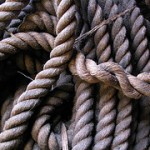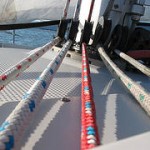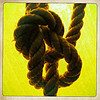 “What’s the difference between a line and a rope?” That is one of my favorite questions to ask new LOON crew members. The answer is that a rope just sits there, with no purpose or use yet, like a pile of rope on the dock or extra rope in your locker. A line is rope with a purpose that’s put to use, like a dock line or halyard for raising sails.
“What’s the difference between a line and a rope?” That is one of my favorite questions to ask new LOON crew members. The answer is that a rope just sits there, with no purpose or use yet, like a pile of rope on the dock or extra rope in your locker. A line is rope with a purpose that’s put to use, like a dock line or halyard for raising sails.
On a recent sail we got to talking about how there are “lines” and “ropes” in organizations, too. You know them; the lines are usually engaged in some constructive pursuit, and the ropes seem to just sit there with little meaningful purpose or activity. On some teams, lines sometimes take most of the strain, including work that some of the ropes should be doing.
usually engaged in some constructive pursuit, and the ropes seem to just sit there with little meaningful purpose or activity. On some teams, lines sometimes take most of the strain, including work that some of the ropes should be doing.
It’s not always a rope’s fault that it lacks purpose or isn’t engaged. I think it was in Robert Mager’s book Analyzing Performance Problems (with the catchy sub-title “You Really Oughta’ Wanna”) that I first heard there are four main reasons that some people (lines) don’t perform:
- They don’t know what. For lack of familiarity with a task or setting, they may simply not know what needs doing. They need an explanation and clear expectations.
- They don’t know how. This is an educational or training opportunity. Inexperienced crew members likely know
 that good knots are important, but no matter how many times they are asked to tie a bowline or clove hitch, if they aren’t shown how it won’t happen.
that good knots are important, but no matter how many times they are asked to tie a bowline or clove hitch, if they aren’t shown how it won’t happen.
- They don’t want to. This is a motivational issue. I am not especially motivated to climb my mast or dive in Lake Superior to free a fouled line, and fortunately so far have had willing and able crew to perform that task! If there was imminent danger that required me to do so, though, I would be motivated. Sometimes people simply don’t want to because it’s not their thing; there’s an interest or skills mismatch.
- There are obstacles. Earlier this summer LOON’s engine water pump blew on our way to Isle Royale. No matter how motivated and able we were to continue our journey, we had to stay put in Grand Marais’ harbor until a replacement pump was shipped. Likewise, if for example a worker’s attempts to assume more responsibility or improve processes are constantly thwarted by an insecure boss, meaningful contributions slow down.
Maybe this counts as an “obstacle” or it’s a fifth reason that someone is a rope instead of a line in our organizations: Lines wear out if not properly cared for, and can snap (at very inopportune times) if over-loaded. I’m afraid that many of our one-time best lines, the doers and innovators in our organizations, are getting worn out and close to the breaking  (quitting) point. Given downsizing and relentless cost-reduction efforts, lines that before held their own are now performing the work of two. Everything seems to change at dizzying speeds; social networks are disrupted and work routines altered, often without reasons about why or needed support.
(quitting) point. Given downsizing and relentless cost-reduction efforts, lines that before held their own are now performing the work of two. Everything seems to change at dizzying speeds; social networks are disrupted and work routines altered, often without reasons about why or needed support.
Here are some tips if we want more lines instead of just ropes in our organization:
- Help people understand not only what needs to be done, but why it is important. Give them more of the context about how their contributions tie in with the bigger picture.
- Satisfy the desire that many have for meaning and a sense of purpose. What needs do your products and services fulfill? What would be missing without your organization’s and their contributions? What’s the vision, where is the organization headed, and why is that important?
- Assure that they have the necessary preparation , and provide training and support, to perform as required.
- Make your organization’s culture and values visible, and encourage self-awareness to facilitate the best matches.
- Remove obstacles – inefficient layouts, unnecessary rules and procedures, unsupportive or intimidating co-workers, outdated tools or technology, bureaucracy, etc. Ask yourself (or better yet ask others) what you might be doing that’s getting in the way.
- Create “truth-telling” cultures. Make it easy for people to talk about how they feel like ropes but want to be lines, and engage in problem-solving with them about how.
- Be a “servant leader.” We may be “the captain of our ship,” but instead of focusing mainly on how others can help us get where we want to go, focus more on how we can help others help us reach a shared destination. It’s a subtle, but important, distinction.
Are you feeling more like a “rope” than a “line” these days? What action will you take to re-engage and contribute more value?
How might you help any “ropes” whom you work with be more like “lines”?
Fair winds!
